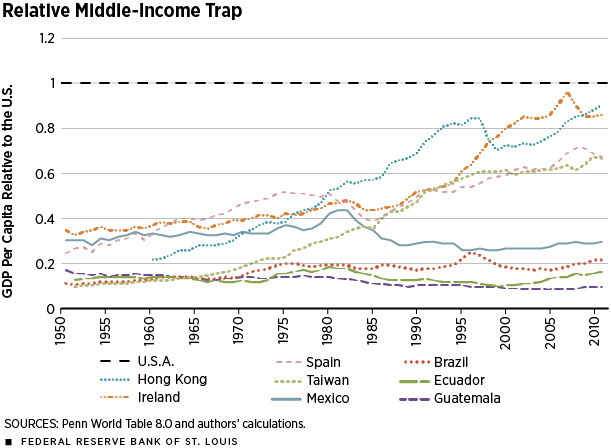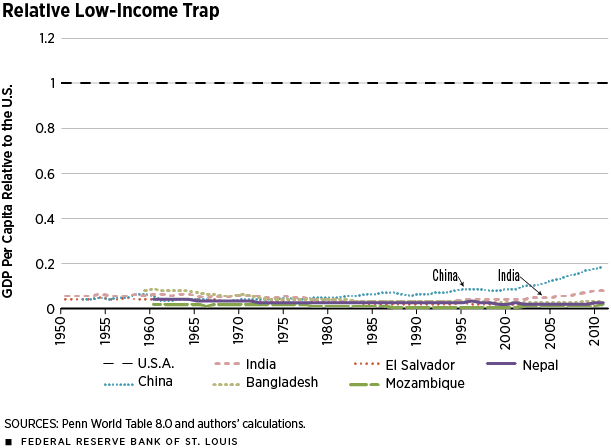As the one-word title of North's JEP article implies, he is perhaps best-known for his work in broadening the view of economics beyond the specifics of producing, and selling and buying, and emphasizing how a broader institutional context set the stage for economic interactions. In Goldin's essay, she traces this focus on the importance of institutions back to some of North's early work on transportation costs and economic growth. Goldin wrote (footnotes omitted):
In the 1950s, a primarily theoretical literature emerged conjecturing that economic growth could be enhanced by decreased transport costs, at least under special circumstances. Even when productivity change is moving at a snail's pace in the goods-producing sectors, a decrease in the price of transportation can increase national income substantially. Developing economies were advised to increase certain capital expenditures if they wanted to grow, especially "infrastructure" and, most especially, transportation. How decreased transport costs affected the economic growth of the United States—the great success story—was a natural. ...
Douglass North's best-known research in transportation concerns ocean shipping from 1600 to 1860. The costs of ocean shipping decreased during much of the period, more so in the nineteenth century than before. A large part of the decrease, argued North (1968), came from an increase in total factor productivity. But the question was whether total factor productivity gains were rooted in technological advances or some other innovation. North found that from 1600 to 1784 productivity advanced at a slow rate, but that virtually all of the gains were due to decreased crew size and less time spent idle in ports. For the period from 1814 to 1860, productivity increased faster, at almost 10 times the annual rate in the previous two centuries. Virtually all the gain here was due to an increase in the size of ships and to their greater load factor. For most of the two and a half centuries considered, goods coming from the New World to the Old World were bulky raw materials, whereas those moving in the other direction were compact manufactured goods. In the 1840s and 1850s, however, there was a large increase in immigration, which meant that ships returned to the New World with cargo, not in ballast. The load factor thereby increased.
The surprising finding is that for both periods, technological change was less responsible for the increase in productivity than were other innovations—a sharp reduction in piracy and organizational changes that increased round-trips per year by a factor of three. With less piracy, ships needed fewer crew members and could carry more goods and fewer armaments. With less need to arm ships, technologically superior vessels could be used. For example, the Dutch "flute," a sailing vessel with a rounded stern, had been used in the Baltic long before the modified flute made it to the ocean. But the reason these superior vessels were used in the Baltic was that piracy had been significantly reduced there, and the flute generally carried no armament. The important point for economic history and for North's intellectual development is that institutions interact with technology. One without the other does not produce economic growth. North learned the lesson well and shifted his attention for the next 25 years to a study of institutions.
North also pointed out how groups in power could use institutions to perpetuate their authority, and that such groups had an incentive to act in this way and hold on to power. even if the overall effects on growth were negative. For example, here's Goldin describing North's analysis of institutions in the US slave-holding South before the Civil War.
According to Douglass North, the roots of southern stagnation are to be found in the geographic patterns of trade in the antebellum period. The South, using slave labor, grew cotton and exported it to the American North and to Britain. With the receipts from its northern shipments it purchased foodstuffs from the Midwest and industrial goods from the North. With its receipts from European shipments, it purchased luxury items and other industrial wares. Little was ploughed back into the South as internal improvements. Schooling was denied slaves and was poorly provided to southerners in general. Cities, those generators of agglomeration economies, were rare in the South. Innovation was thereby stifled.
The North ran a very different ship. With far more equality of income and wealth, northerners purchased goods produced by local tradesmen and local firms. Its funds were ploughed back into local industry and internal improvements. Its people were the best educated in the world. The North established institutions that served an egalitarian society and that furthered an industrial and growing region. The South had norms that reinforced a caste and race-based society and that inhibited growth at the service of a master class. Such institutions have long lives.
The message, repeated in many of Douglass North's later works, is that when institutions serve to enrich one group (masters, feudal lords) at the expense of another (slaves, serfs), it does not matter that these institutions also reduce the potential income of the elite. Pareto-improving trades are generally impossible between the two groups, and thus there is no assurance that more efficient institutions will drive out less efficient ones.
In North's JEP essay, North begins with a succinct summary of his view of the centrality of institutional development in understanding economic history and the performance of economies over time. North wrote:
Institutions are the humanly devised constraints that structure political, economic and social interaction. They consist of both informal constraints (sanctions, taboos, customs, traditions, and codes of conduct), and formal rules (constitutions, laws, property rights). Throughout history, institutions have been devised by human beings to create order and reduce uncertainty in exchange. Together with the standard constraints of economics they define the choice set and therefore determine transaction and production costs and hence the profitability and feasibility of engaging in economic activity. They evolve incrementally, connecting the past with the present and the future; history in consequence is largely a story of institutional evolution in which the historical performance of economies can only be understood as a part of a sequential story. Institutions provide the incentive structure of an economy; as that structure evolves, it shapes the direction of economic change towards growth, stagnation, or decline.In some ways, North's emphasis on institutions has become so embedded in economic thinking that it runs the risk of sounding obvious. By now, everyone is familiar with the big idea that institutional traits like property rights and the rule of law play a central role in economic performance. But every big insight--like "institutions matter"--sounds obvious when it is raised to a high level of abstraction. The more lasting insights come from a double process: first digging down into the specifics of different times and places so that you can be specific about which institutions mattered at which times and for reasons, and then taking the next step of looking for commonalities and patterns across the landscape of these specific studies. North led the way in showing how to do these kinds of studies, and did far more than his fair share of them. But as North wrote at the end of his JEP essay in 1991:
The foregoing comparative sketch probably raises more questions than it answers about institutions and the role that they play in the performance of economies. Under what conditions does a path get reversed, like the revival of Spain in modern times? What is it about informal constraints that gives them such a pervasive influence upon the long-run character of economies? What is the relationship between formal and informal constraints? How does an economy develop the informal constraints that make individuals constrain their behavior so that they make political and judicial systems effective forces for third party enforcement? Clearly we have a long way to go for complete answers, but the modern study of institutions offers the promise of dramatic new understanding of economic performance and economic change.(Full disclosure: I've worked as Managing Editor of the JEP since the first issue in 1987. All JEP articles from the first issue to the present are freely available online courtesy of the journal's publisher, the American Economic Association.)












